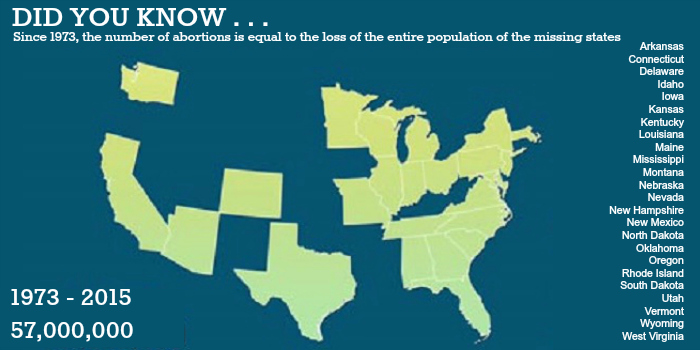After 42 years of legal abortion, how does one even comprehend 57 million unborn children aborted? Oregon Right to Life came up with a YouTube video that helps us get our heads around: “How many is 57 million?”
The 4 ½ minute long video begins by declaring: “The United States Legalized Abortion in 1973.” Then, as the screen shows the date change to 1974, 1975, ‘76 and so on, the number of babies aborted ticks up — really fast. In 1983, after just ten years, the number of abortions surpasses 13 million. Above the numbers, there’s a map and, as the numbers roll, whole states begin to disappear. They just drop off the map as the number of abortions keeps rising. The numbers stop rolling at 2014. By then, the map depicts a country that’s split up with huge swaths missing.
A devastating picture.
This month especially we pray for an end to abortion. Today, the numbers are down, but, still, 21 percent of pregnancies end in abortion. That’s one fifth of babies — aborted.
We pray that restrictions on abortion would be upheld. Last week, the United States Court of Appeals for the Fifth Circuit heard oral arguments in a case challenging Texas’s law regarding abortion clinics. The law requires that these facilities meet the staffing, construction, and equipment standards of ambulatory surgery centers. States legislatures reasoned: if women have a so-called right to choose abortion, they at least deserve the safest abortion possible. That’s also why states are passing laws requiring that abortionists have admitting privileges at a local hospital. Plus, many states are now requiring that women be given the option to view sonograms of their unborn babies. And mandatory counseling and waiting period laws are being passed across the nation.
These laws face court challenges. Last month the Fourth Circuit Court of Appeals struck down North Carolina’s sonogram law. The Fifth Circuit has already upheld similar legislation passed in Texas. North Carolina’s law included a 24-hour waiting period and required the mother to be given certain information before consenting to an abortion. The state’s attorney general says he’ll appeal it to the U.S. Supreme Court.
The U.S. Congress isn’t wasting any time resuming debate over laws forbidding late term abortions. Representatives Trent Franks of Arizona and Marsha Blackburn of Tennessee introduced the “Pain Capable Unborn Child Protection Act.” This law prohibits abortion after 20 weeks — that’s five months — gestation. The law’s findings, stipulating that the unborn child can feel pain at that age, are meant to deter women from having abortions.
This year’s March for Life, which takes place February 22 on the National Mall in DC, focuses on abortions done because of the discovery of a prenatal disability. “Every Life is a Gift” is the theme — and March for Life President Jeanne Monahan adds “even ones that are not perfect.”
She is so right.
 Listen Online
Listen Online Watch Online
Watch Online Find a Station in Your Area
Find a Station in Your Area










 Listen Now
Listen Now Watch Online
Watch Online
